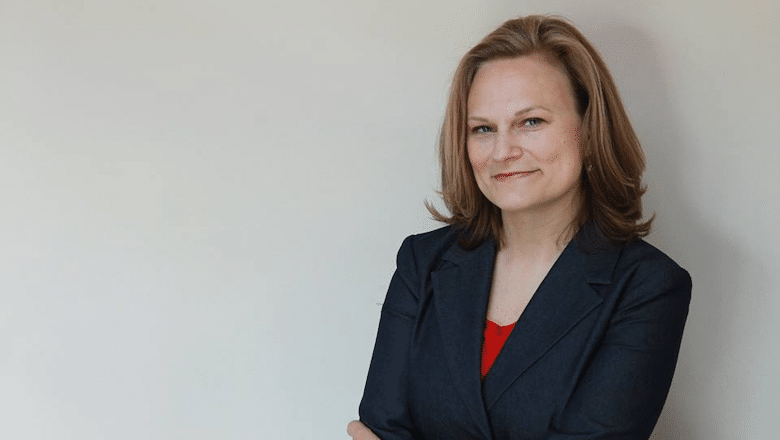Spotlight: Vice President of Planning and Customer Engagement
GreenerU's Jennifer Haugh leans into the complex. Learn how she believes in the healing powers of stakeholder engagement—and how her background in art and music makes her the perfect fit to lead your climate action planning process.

French horn performance was going to be Jennifer Haugh’s career.
“If you look carefully at the 1992 Super Bowl halftime show video on YouTube, you’ll catch a glimpse of my face among the kids wearing white tuxedos in the symphony orchestra,” she says. “And yes, we knew it was ridiculous at the time.”
But an appreciation for complexity and versatility led Haugh down a different path at the University of Minnesota, where she got her bachelor’s degree in music, history, and cultural studies.
“I lean toward places where different disciplines overlap. Like how you can hear what it felt like to live under fascism in Dmitri Shostakovich’s 1930s symphonies, or how abstract artwork of the Impressionist era actually reflected France’s tremendous sense of loss after the Franco-Prussian War.”
Haugh found the perfect job out of college at Minnesota Citizens for the Arts, a grassroots advocacy organization, where she helped bring armies of arts advocates to the Minnesota State Capitol to meet with legislators and ask for funding support.
“I learned a lot of important lessons from my work at MCA,” Haugh says. “We had the benefit of arts funding reaching every single legislative district in the state. Legislators would hear directly from recipients about the personal impacts the arts have had in their lives.” Today, Minnesota ranks third in the nation in per-capita state funding for the arts.
“A big part of our success was in teaching advocates some communications basics: hone your message, keep it simple, and always say thank you. We were big believers in celebrating our advocates and legislators.”
Let’s get engaged
During her time at MCA, Haugh began developing facilitation skills through volunteering. In 2000, she was a mayoral appointee to the Minneapolis Arts Commission, a 17-member citizen body formed to advise the Mayor and City Council on matters relating to public art installations, arts policies, and artists. By 2002, she was elected co-chair; in 2003, she chaired the Commission solo.
“Minneapolis was undergoing a shift in the way the City supported artists at that time,” she says. “Community engagement was baked into the way public art projects were developed. Artists were encouraged to seek input and ideas from the surrounding neighborhood to reflect the culture of the neighborhood.”
Not every installation followed that process, however.
When Ameriprise approached the Minneapolis Convention Center with an idea to sponsor a mural in a highly visible location next to an interstate exit ramp, the artist had already been selected and a design developed before the City stepped in.
“That particular space was so large [5,500 square feet] and at such a busy location that the City felt any artwork put there should be vetted by the community,” says Haugh. “The Convention Center folks were not particularly excited about the City calling those decisions into question.”
By way of compromise, the artist was asked to work with inner-city high school students on the development of a portion of the design through a photography class. “He ended up saying that was his favorite part of the whole process. It was far more meaningful to weave in the stories and photography of kids who would grow up to see their works on display downtown for decades.”
Haugh was quickly coming to understand that stakeholder-driven decision-making processes result in strong outcomes.
“A lot of stuff comes to the surface during these discussions, even if the topic is about art. There can be a lot of long-standing pain as well as joy and pride. Facilitating these conversations is a bit like being a therapist: you are navigating tensions and trying to create cohesion via a common goal.”
“Ultimately,” she adds, “whether you’re talking about where to site public art or a wind turbine, or decide how to create goals as a group, the process—though messy and complicated—can serve to iron out differences and build consensus.”
Meeting facilitation and leadership
Haugh realized the Minneapolis Arts Commission and Minnesota Citizens for the Arts were excellent starting points for learning meeting management. Reporting to the City Council and Mayor, MAC meetings followed Robert’s Rules of Order; MCA’s executive director had worked as a committee administrator for the Minnesota Senate and structured board and committee meetings similarly. Formal meeting rules were drilled into Haugh’s facilitation style from the get-go.
“I am extremely conscious of the time,” she says. “Ten people in an hour-long meeting is ten hours of time. And time is one of our most precious commodities.”
Thoughtful meeting planning and following a detailed agenda is therefore essential to making the best use of people’s limited time and bandwidth. “I’ve found that people’s willingness to participate increases dramatically when you prove that you understand that their time is valuable.”
Haugh also found that nonprofit board membership was an opportunity to develop leadership skills, and she ultimately chaired the boards of Encore Wind Ensemble, Sapphire Chamber Consort, and Coffee House Press.
“I think I was sought after for board leadership because I was willing to put in the time,” she says. “But also because I knew how to get things done.”
Her goal with the Coffee House board, she added, was to build a board she was “no longer eligible to serve on”—namely, that meetings were so productive that the press could attract increasingly more professional members from higher up the corporate ladder.
She succeeded.
A shift to climate
Following a period of time in corporate communications and media relations for American Public Media, Haugh left for Boston to attend graduate school. She earned a Master in Public Administration at the Harvard Kennedy School of Government, followed by a Master in Design Studies at the Harvard Graduate School of Design.
“Ironically, my studies at the GSD ended up having very little to do with design and a lot more to do with environment and community engagement,” she explains. “I pursued that degree with the intention of starting a consulting business that combined the passion I developed for process facilitation with a need to do something about my rapidly growing concerns about climate change.”
There she wrote a thesis entitled Please in My Back Yard: Mitigating the Aesthetic Effects of Wind Turbines, which became the basis for a business concept.
“Effectively, the thesis outlined how stakeholder-engaged processes could counteract resistance to a changing visual landscape. I felt there might be a market for renewable energy companies trying to smooth the way toward faster siting of large-scale projects,” she says. “At the time, public opposition to Cape Wind was fierce. And ultimately that killed the project, even after the developer spent $100 million on siting and permitting and such.”
With the idea of transforming renewable energy projects into cultural icons through public art and civic engagement, she entered and became a finalist of the 2014 Harvard Dean’s Cultural Entrepreneurship Challenge, adjudicated by Yo Yo Ma.
An almost three–year run with Iconic Energy Consulting included facilitating stakeholder engagement in constructing an 11-million-gallon wet-weather storage facility on an existing bike path in an arts district in Lexington, Kentucky. She also commissioned a place-based “energy-feedback sculpture” competition that would help Harvard freshmen connect to their energy consumption on campus.
Haugh worked to strengthen her command of climate issues, becoming a Rappaport Institute for Public Policy fellow with the Department of Energy Resources’ Leading By Example program, as well as an interim project manager for Harvard’s Office for Sustainability.
Additionally, Haugh developed a separate business, Haugh Communications, which drew a steady stream of clients looking for help with thesis editing, ghost-writing, developing educational materials, and sprucing up resumes.
A symphony of skills
In 2017, Haugh started with GreenerU as Marketing Manager. “If I’d been looking for a traditional marketing person, she would have been the worst candidate for the role,” says David Adamian, former CEO of GreenerU. “But we were looking for someone a bit more multifaceted.”
During her time at GreenerU since then, Haugh has developed annual marketing strategies, facilitated an internal strategic planning process, overhauled the website, and written countless blog posts, proposals, and other material.
She has designed sustainability and climate action plans for several clients, including Portland Community College, UMass Chan Medical School, University of Texas Arlington, The Fenn School, and the University of Rochester.
And she has worked directly with a range of clients, including Boston College, Concord Free Public Library, UMass Chan Medical School, and the University of Rochester on developing or implementing climate actions.
“Jen never shies away from a problem,” says Rob Durning, GreenerU’s CEO. “At every turn, she has jumped at the opportunity to take on new client challenges and lead company-wide strategic efforts.”
“The role I’m in now feels like the arrival point of nearly everything I’ve done before in my life and career,” says Haugh. “Each role I’ve taken on before has come together in a pretty exciting way at GreenerU, where I’ve been able to thrive by being myself.”
What about the French horn?
“I still play it sometimes,” she says.
“It may seem unconnected, but my training as an orchestral musician taught me about everything it takes to move the needle on climate action in a nutshell: teamwork, timing, listening, communication, and collaboration.”



